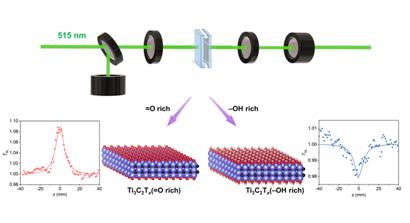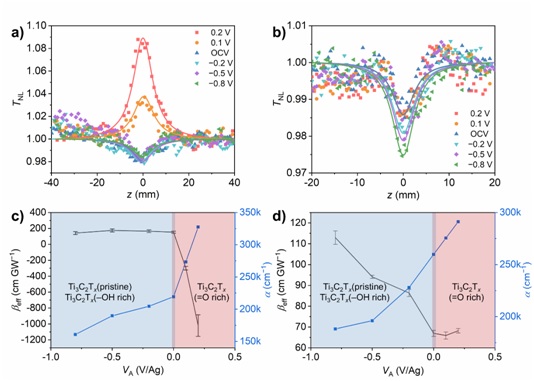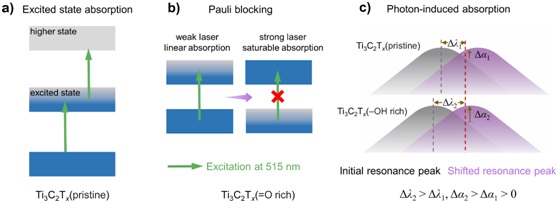
Graphical Abstract
Professor Huang Zhipeng and Academician Zhang Chi's team has made important progress recently in switching nonlinear optical absorption of MXenes by modulation of the surface terminations of titanium carbide MXenes by electrochemical means, publishing relevant outcomes inACS Nano(ACS Nano, 2022, 16 (1), 394-404).
With the development of laser techniques, nonlinear optical materials have a broad prospect in the fields, such as laser, communication, and material analysis. Thanks to the strongexciton effect, ultrafast carrier dynamics and high charge delocalization, 2D nonlinear optical materials stand out among various nonlinear optical materials and become a research hotspot of nonlinear optical materials.The previous studies show good nonlinear optical properties of substances, including graphene, black phosphorus, metal sulfides, and MXenes. However, the commercial application of 2D nonlinear optical materials has long been hindered by their inconsistent properties, and the same materials synthesized with different methods even show opposite nonlinear optical properties. Therefore, the focus of research on 2D nonlinear optical materials lies in the reproducible synthesis and the structure-activity relationship betweenthe nonlinear optical properties of 2D materials and their structures.
The researchers revealed the structure-activity relationship between the nonlinear optical properties of materials and the surface terminations via modulation of the surface terminations of titanium carbide MXenes by electrochemical treatment and proposed a nonlinear optical absorptionmodulation strategy based on the surface termination types of 2D materials.It was found that the main termination types of titanium carbidenanosheets changed at different electrochemical potentials.The =O rich MXenes (compared to un-modulated pristine samples for numbers of terminations) exhibited a saturable absorption response with laser excitation at 515 nm, while reverse saturable absorption was found in the ‒OH rich samples and pristine samples under the same test conditions. The MXenes with different terminations exhibited reverse saturable absorption response with laser excitation at 800 nm, but the magnitude of the performance was related to the termination types. The ‒OH rich samples showed a stronger performance. The results not only show that the surface termination types have an important influence on the nonlinear optical properties of 2D materials, but also provide a convenient and effective means for dynamically modulating the nonlinear optical properties of MXenes.

Figure 1 Nonlinear optical test of 2D material MXenes
With laser excitation at 515 nm, the pristine and ‒OH rich MXenes samples show reverse saturable absorption attributed to excited-state absorption; in the =O rich samples, fewer energy bands above the Fermi level result in decreasing vacant bands that act to accumulate excitation electrons, inhibiting excited-state absorption, and leading to a Pauli blocking effect with the laser intensity increases, and therefore causing saturable absorption.With laser excitation at 800 nm, since MXenes exhibit plasmaresonance absorption at a wavelength of 645~755 nm,the photons are absorbed by the electrons near the Fermi level in plasma resonance, resulting in a temperature increase of the electrons and the resonance peak subject to red shift of the excited sample, thus exhibiting different nonlinear optical responses on the low-energy and high-energy sides of the linear plasma resonance peak. For photons with a wavelength less than the resonant wavelength, absorption is reduced and thereforephoton bleaching occurs; for photons with a wavelength greater than the resonant wavelength, photon-induced absorption may occur.The absorption wavelength in the experiment was less than 800 nm, so reverse saturable absorption occurred, in a response intensity related to the distance between the excitation wavelength and the center of the plasma resonance peak. The closer the excitation wavelength is to the center of the resonance peak, the smaller the increase in absorption and the weaker the reverse saturable absorption. Therefore, the ‒OH rich MXenes sample has a stronger reverse saturable absorption at 800 nm.

Figure 2 Schematic Diagram of Nonlinear Optical Absorption Process of 2D Material MXenes
Dr. Li Hui, a postdoctoral candidate, and Chen Saiyi, a doctoral candidate of our school, contributed as the co-first authors of the paper, and Professor Huang Zhipeng and Academician Zhang Chi as the co-corresponding authors of the paper. The research work was supported by the National Natural Science Foundation of China as a key project and general project, the Program for Innovative Research Team in University by the Ministry of Education, the Program for Innovative Research Team in Key Fields by the Ministry of Science and Technology, and Key Projects of Science and Technology Innovation Plan of Shanghai Municipal Education Commission.